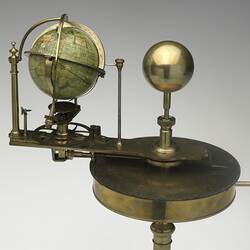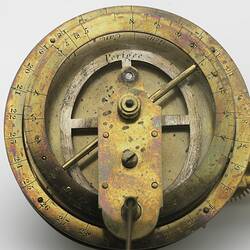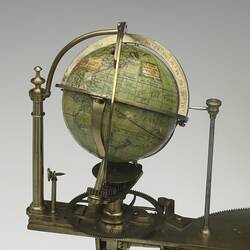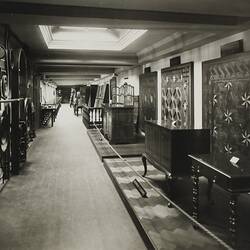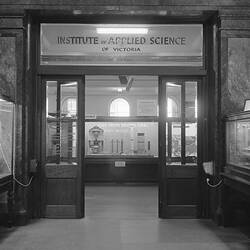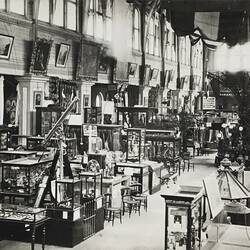Summary
An orrery is a mechanical model of astronomical motions. Generally they were intended to be schematic representations for educational purposes rather than strictly accurate ones.
Orreries called planetariums show planetary orbits and their relative speeds. Tellurians demonstrate the motions of the Earth and the cause of the seasons. Lunariums show the motions of the Moon.
This orrery has two separate attachments, a tellurian and lunarium, but does not include a planetarium attachment.
Benjamin Martin was the first to construct good orreries that were less expensive. This is one of his later works.
Physical Description
Brass circular mechanism 17cm diameter supported on base with 3 folding legs. Plate also has concentric circles near edge showing date & signs of zodiac. Centrally above mechanism is brass ball representing sun. Tellurium or lunarium can be fitted onto axis below sun. At later date a brass circle was added to globe to show longitude. Also a semi-circle on n-s line to show latitude. Howver, this interfered with operation so has been removed and is stored in Orrery's box.
Significance
Benjamin Martin was an important instrument maker in the development of the orrery. Moreover only a small number of original Martin orreries are known to have survived. Therefore this item is of considerable global significance.
Martin was primarily responsible for a number of developments in orrery design that reduced their cost. He was thus the first to build orreries for the well-off middle classes; prior to Martin only the very wealthy could afford such devices. One such innovation was the "double cone" construction for orreries, which allowed orreries to be built with simpler gearwork, while still achieving accurate ratios for orbits. Martin popularised (but did not invent) this technique. Another innovation of Martin's was to fix planets to extended wire arms, rather than on brass plates. Both of these innovations survived in later orreries, although not in the precise form that Martin developed. By the nineteenth century, orreries were cheap enough to be used in at least some schools.
This orrery is one of Martin's later works. It closely matches the description of the orrery described by John Millburn in 'Benjamin Martin and the Development of the Orrery' apart from having a different form of signature.
The globe on the orrery in the collection depicts the east coast of Australia and New Zealand and so post-dates Cook's mapping, while Martin died, insolvent, in February 1782. Thus, the latest possible date for this orrery is 1781 and the earliest is 1773,
More Information
-
Collecting Areas
-
Acquisition Information
Purchase
-
Maker
Mr Benjamin Martin, London, England, Great Britain, circa 1770
-
Inscriptions
Upper plate of mechanism engraved "B. Martin, London".
-
Classification
-
Category
-
Discipline
-
Type of item
-
Overall Dimensions
415 mm (Length), 330 mm (Width), 250 mm (Height)
-
Object Measurements
38.5 cm (Height), 25.5 cm (Outside Diameter)
-
Exhibition Collection Management
415 mm (Length), 330 mm (Width), 250 mm (Height)
-
Dimensions
38.5 cm (Height), 25.5 cm (Outside Diameter)
Measurement From Conservation. Measuring Method: Object without box - assembled
-
References
Martin, Benjamin. (1771). The description and use of an orrery of a new construction. London: printed for, and sold by the author, and by the booksellers in city and country. Millburn, J. (1973). Benjamin Martin and the Development of the Orrery. The British Journal for the History of Science, 6(4), 378-399.
-
Keywords

